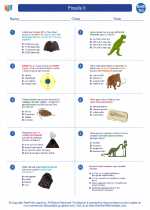Fossils II -> crust
Crust
The Earth's crust is the outermost layer of the Earth. It is a solid, thin, and relatively cold layer that varies in thickness from about 5 to 70 kilometers. The crust is composed of a variety of rocks, minerals, and sediments, and it is divided into two main types: continental crust and oceanic crust.
Continental Crust
Continental crust is the thicker and less dense type of crust that forms the continents and the areas of shallow seabed close to their shores, known as continental shelves. It is primarily composed of granite rocks and is less dense than oceanic crust, which allows it to "float" higher on the denser mantle below.
Oceanic Crust
Oceanic crust is the thinner and denser type of crust that underlies the ocean basins. It is primarily composed of basalt rocks and is denser than continental crust, causing it to "sink" lower on the mantle. Oceanic crust is constantly being created at mid-ocean ridges through volcanic activity and is destroyed at subduction zones where it sinks back into the mantle.
Study Guide
- What is the Earth's crust?
- What are the two main types of crust?
- Describe continental crust.
- Describe oceanic crust.
- How does the composition and density of continental and oceanic crust differ?
- Where is oceanic crust created and destroyed?
- Why does continental crust "float" higher than oceanic crust?
Studying the Earth's crust is essential to understanding the structure and composition of the Earth's outermost layer. By learning about the differences between continental and oceanic crust, as well as the processes that shape and transform them, students can gain a deeper understanding of the dynamic nature of the Earth's surface.
.


